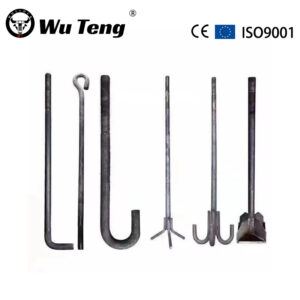How to choose anchor bolts
1、 Basic Definition
Structural characteristics: usually composed of threaded rods and anchoring sections, pre embedded or placed in concrete foundations;
Mechanical function: As a "stabilizer", it disperses equipment loads to the foundation, resisting vibration, impact, and external environmental forces.
2、 Main types
Classified by structure and application characteristics
Fixed anchor bolt (short anchor bolt)
Characteristic: Integrated with basic irrigation, non removable
Purpose: To fix equipment without strong vibration or impact, such as ordinary mechanical foundations
Installation requirements: Ensure the compactness of pouring and the verticality of bolts
Activity anchor bolt (long anchor bolt)
Features: Detachable design, allowing for adjustment of equipment position
Usage: Fixed heavy equipment with strong vibration or large impact (such as generators, heavy machine tools)
Expansion anchor foot bolt
Characteristic: Fixed by the principle of expansion, installation requires drilling holes
Usage: Static placement of simple equipment or auxiliary equipment (such as pipeline supports)
Installation requirements:
The distance from the center of the bolt to the edge of the foundation is ≥ 7 times the diameter of the bolt
Basic strength ≥ 10MPa
Drilling should avoid steel bars and have no cracks
Adhesive anchor bolts
Characteristic: Fixed with high-strength adhesive
Purpose: For scenarios requiring high adhesive strength (such as precision equipment foundations)
Installation requirements: Clean the debris inside the hole and prevent moisture
Classified by performance level
4.8 level, 6.8 level, 8.8 level
Encoding rule: The number before the dot represents the tensile strength (× 100 MPa), and the number after the dot represents the yield strength ratio (yield strength/tensile strength)
Application:
4.8 and 6.8 levels: ordinary transmission towers, low vibration equipment
Grade 8.8 and above: High load or vibration environment (such as bridges, wind turbines)
Special type (by shape/installation method)
Pre embedded foundation bolts
Pre embedded foundation, secondary fastening during equipment installation to ensure positioning accuracy
T-shaped/L-shaped anchor bolt
The head shape adapts to specific installation environments, such as narrow spaces or irregular structures
3. Match materials according to environmental conditions
Carbon steel bolts (such as Q235)
Advantages: High economy, suitable for general dry environments
Restriction: Galvanized or coated with anti rust paint to resist slight corrosion
Stainless steel bolts (such as 304/316)
Advantages: Acid and alkali resistance, humid environment (such as chemical plants, coastal areas)
Disadvantages: High cost, slightly lower tensile strength than alloy steel
Alloy steel bolts (such as grade 8.8 and above)
Applicable scenarios: high load or extreme working conditions (such as bridges, wind turbine towers)
Performance requirement: Yield strength ≥ 640MPa, to be used in conjunction with high-strength nuts
4、 Typical application scenarios
Infrastructure: high shear bearing capacity scenarios such as bridges, tower cranes, and large-span steel structures;
Industrial equipment: scenarios that require long-term stable operation such as power facilities and heavy machinery;
Special environment: Stainless steel or anti-corrosion coated bolts are often used in corrosive environments such as coastal areas and chemical industries.
(Note: The selection should comprehensively consider equipment load, vibration frequency, and foundation conditions. For some scenarios, the pre embedded depth and specifications need to be determined through professional calculations.)

Post time: 5月-08-2025




